But the situation has begun to change in recent years. The ongoing slowdown of China’s economy — affected by COVID-19 and the downturn of its domestic property market — is likely to have a significant impact due to lower demand for commodities. China imports over 70 per cent of global iron ore, 72 per cent of aluminium and over 60 per cent of copper. From the demand-side, China’s economic dynamics inevitably affect commodity prices in international markets.
After a decline in COVID-19 cases, there was hope that China would experience an economic rebound and return to pre-pandemic levels. But China’s economic reopening in the second quarter of 2023 has been slower than predicted. China’s economic growth in 2023 is expected to be 5.2 per cent, before further falling to 4.5 per cent in 2024. As Indonesia’s largest trading partner, the impact of China’s weakening economy will be felt in Indonesia’s commodity market.
From the supply side, global commodity prices are still relatively high due to supply chain problems. Indonesia enjoyed substantial revenue from commodity exports in 2022 amid the Russia–Ukraine war. In 2023, commodity prices have slowly started to decline, though they are still categorised as high. The International Monetary Fund projects Indonesian economic growth to be five per cent in 2023, a decrease from the 5.3 per cent realised in 2022, due to tighter global monetary policy and normalisation of commodity prices.
In 2022, the top commodities exported from Indonesia to China were iron and steel (US$ 19 billion), mineral fuels (US$17.9 billion), animal and vegetable oils (US$6.4 billion) and nickel (US$4.5 billion). Nickel had an export value 13 times greater than the previous year, in line with the growing interest in the development of low-carbon technologies and downstream efforts by the Indonesian government.
Various dynamics in the global economy have made Indonesia re-examine its economic policy when it comes to commodities. Any policy overhaul will have a significant impact considering that about two-thirds of Indonesia’s exports depend on natural resources. Any further decline in commodity prices will noticeably reduce government revenue — affecting both export taxes and non-tax revenue channels.
Efforts to diversify Indonesian export destinations for commodities is critical, considering the prospect of China’s economic slowdown. In recent years, crude palm oil (CPO) and the coal export market have been highly concentrated in India and China. The downturn in Chinese demand can be seen in the 2022 decline of CPO exports by 18.4 per cent and coal by 55.7 per cent. Exploring new markets, such as Africa, could be a viable solution.
The next issue is how Indonesia can move from only exporting raw materials to products that have added value through the downstream industrial policy. The implementation of the downstream policy needs to consider the various costs and benefits, since not all commodities can be down streamed. Home to the world’s largest nickel reserves, Indonesia is currently focused on encouraging investment in downstream nickel commodities.
Serious efforts to implement a downstream policy are evident in the ban on exports of nickel ore in 2020 and bauxite in June 2023. A rule that mandates processing nickel domestically can attract investment in smelter construction, especially from China, to produce advanced products such as stainless steel. Instead of being sold in international markets, the government aims to deposit domestic nickel ore in smelters, as processed nickel can generate more export revenue for Indonesia compared to exports of raw materials.
The downstreaming process in the CPO sector also needs attention because it is labour-intensive compared to the mineral sector, including nickel, which tends to be capital intensive. Oil palm plantations employ between 3.7–8 million Indonesian workers. When downstream industries are incorporated, labour absorption increases to 16 million. The downstream process in this sector also needs to consider processing management quality to align with sustainability regulations. The European Union has begun to enforce the European Union Regulation on Deforestation-free Products, which will require CPO exports to meet traceability requirements.
The dynamics of commodity cycle prices can be driven by diverse factors, including the slowdown of the Chinese economy. The potential decline in exports and government revenue due to China’s economic downturn needs to be accounted for. Indonesia must reduce its dependence on traditional export markets and start looking for new markets. But first, the government will need to increase the value add of commodities to increase its revenue.
Nabiel Arzyan is Senior Analyst at CReco Consulting, Indonesia.

